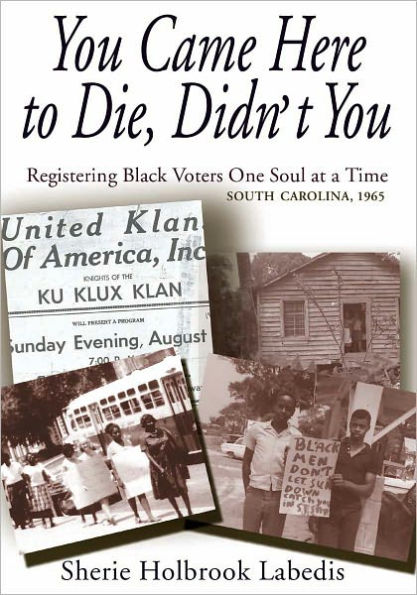You Came Here to Die, Didn't You
Burnings, beatings, and ballots are what I remember about the Civil Rights Movement during the summer of 1965. I was a blond, white, eighteen-year-old student at the University of California, Berkeley, who volunteered for a voter registration project in Pineville, South Carolina because I believed in freedom and equality. Most books about the Movement are written by African-Americans or academics. This one is different. It's written by a white woman who helped make it happen.
Martin Luther King's compelling oratory lured me south, but reality struck the day I arrived when a barefoot black teenager clad in sweaty bib overalls challenged, "You came here to die, didn't you," and it wasn't a question.
The rotting flesh of a woman dying without medical care ended my innocence. My reliance on safety shattered when two black passengers were beaten when the car I drove was forced off the highway. Grits and hog-head stew, mosquitoes, debilitating heat and a restricted life style tested my composure. Conviction wavered as I watched the church we attended reduced to ashes.
Middle-class and spoiled, I was my own biggest challenge - not the southern bigots, the white-hooded Klansmen or a regional culture much more restrictive than California’s. This book explains how I adapted and flourished.
1104252362
Martin Luther King's compelling oratory lured me south, but reality struck the day I arrived when a barefoot black teenager clad in sweaty bib overalls challenged, "You came here to die, didn't you," and it wasn't a question.
The rotting flesh of a woman dying without medical care ended my innocence. My reliance on safety shattered when two black passengers were beaten when the car I drove was forced off the highway. Grits and hog-head stew, mosquitoes, debilitating heat and a restricted life style tested my composure. Conviction wavered as I watched the church we attended reduced to ashes.
Middle-class and spoiled, I was my own biggest challenge - not the southern bigots, the white-hooded Klansmen or a regional culture much more restrictive than California’s. This book explains how I adapted and flourished.
You Came Here to Die, Didn't You
Burnings, beatings, and ballots are what I remember about the Civil Rights Movement during the summer of 1965. I was a blond, white, eighteen-year-old student at the University of California, Berkeley, who volunteered for a voter registration project in Pineville, South Carolina because I believed in freedom and equality. Most books about the Movement are written by African-Americans or academics. This one is different. It's written by a white woman who helped make it happen.
Martin Luther King's compelling oratory lured me south, but reality struck the day I arrived when a barefoot black teenager clad in sweaty bib overalls challenged, "You came here to die, didn't you," and it wasn't a question.
The rotting flesh of a woman dying without medical care ended my innocence. My reliance on safety shattered when two black passengers were beaten when the car I drove was forced off the highway. Grits and hog-head stew, mosquitoes, debilitating heat and a restricted life style tested my composure. Conviction wavered as I watched the church we attended reduced to ashes.
Middle-class and spoiled, I was my own biggest challenge - not the southern bigots, the white-hooded Klansmen or a regional culture much more restrictive than California’s. This book explains how I adapted and flourished.
Martin Luther King's compelling oratory lured me south, but reality struck the day I arrived when a barefoot black teenager clad in sweaty bib overalls challenged, "You came here to die, didn't you," and it wasn't a question.
The rotting flesh of a woman dying without medical care ended my innocence. My reliance on safety shattered when two black passengers were beaten when the car I drove was forced off the highway. Grits and hog-head stew, mosquitoes, debilitating heat and a restricted life style tested my composure. Conviction wavered as I watched the church we attended reduced to ashes.
Middle-class and spoiled, I was my own biggest challenge - not the southern bigots, the white-hooded Klansmen or a regional culture much more restrictive than California’s. This book explains how I adapted and flourished.
4.95
In Stock
5
1

You Came Here to Die, Didn't You
187
You Came Here to Die, Didn't You
187eBook
$4.95
Related collections and offers
4.95
In Stock

Product Details
| BN ID: | 2940012848369 |
|---|---|
| Publisher: | Smokey Hill Books |
| Publication date: | 01/06/2011 |
| Sold by: | Barnes & Noble |
| Format: | eBook |
| Pages: | 187 |
| File size: | 431 KB |
About the Author
From the B&N Reads Blog
